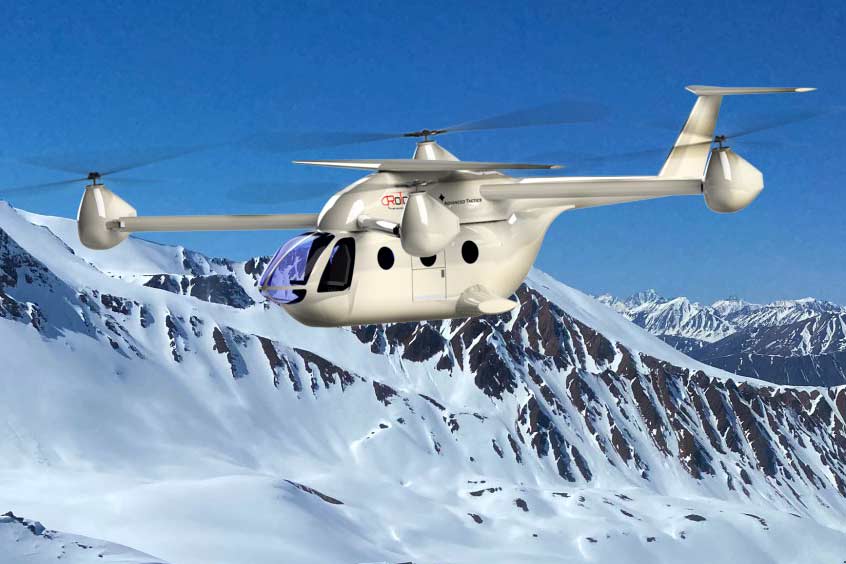Why visit ACE ’25?

The Rotor X Aircraft Manufacturing Company (RX), makers of the Rotor X Phoenix A600 turbo helicopter, which is known as an affordable and reliable two-seat kit helicopter, is entering the electric air taxi market with the RX eTransporter.
RX is now operating the former RotorWay International factory in Chandler, Arizona, which made kit helicopters for 53 years. The patent pending RX eTransporter is more efficient and less expensive than other eVTOL concepts being proposed or developed today. RX is working in collaboration with its partner company Advanced Tactics Inc (AT) of Torrance, California. This four-rotor (or quad-rotor) helicopter named the RX eTransporter, is the first of its kind for civilian and industrial use. This six-passenger helicopter provides plenty of leg room and comfortable charter-jet type interiors, and the open interior version is ideal for air taxi operations, package delivery, SAR, personnel recovery and medevac operations.
Typical eVTOL air taxi aircraft use small inefficient propellers for vertical lift, have complex and expensive geometries, complex engine drive-systems and tilt-mechanisms, inefficient wings and less payload capacity, even with the extensive use of expensive carbon-fibre construction, says RX. Instead of relying on a large wing to make the aircraft more efficient after takeoff, the RX eTransporter uses a smaller wing that only enhances the natural lift of this helicopter. It does not require a tail rotor; increasing the aircraft's efficiency. The RX eTransporter can takeoff and land vertically and fly for over 1.5 hours, or hover for over 45 minutes on a single charge. Having strong eVTOL hovering capability makes the RX eTransporter suited for commercial cargo and personnel flights immediately after completing FAA airworthiness testing next year.
The RX eTransporter technology has been in development for over a decade, with many heavy lift multi-rotor prototypes completed by partner company Advanced Tactics Inc (AT). AT is considered a pioneer of heavy lift multi-rotor aircraft. Its eight-engine Black Knight Transformer flew in 2014 and its gross takeoff weight was in excess of 4,500 pounds. At the time this was developed, heavy lift multi-copters weighed about one tenth of this weight. The Black Knight Transformer carried an automobile engine and drivetrain as part of its payload and could drive on the ground and fly. It had an overall payload, including the automobile drivetrain, in excess of 1,500 pounds.
Rotor X Aircraft has partnered with Advanced Tactics in developing and pioneering heavy lift multi-rotor technology and is the prime manufacturer for both the civilian and military Transporter configurations. AT is the primary rapid prototyping and design arm of this partnership. AT works with the US Air Force on two current contracts related to the RX eTransporter.
The RX eTransporter will start testing in Alaska as an experimental aircraft during the summer of 2022. Mining companies have shown strong interest in purchasing the aircraft to carry mining equipment in the rugged terrain of the Alaska Range. As mining operations expand, the RX eTransporter helicopter would greatly reduce costs. The new battery and quick charging systems are also uniquely adapted to cold weather operations.
Across the mining industry, drones are already demonstrating exceptional results by enabling much greater data collection, enhanced safety and improved productivity. The heavy-lift RX eTransporter, which can be manufactured in a pilot-optional version and still carry over a ton of cargo, could be a game-changer for the mining industry. That capability will support essential tasks like fuel delivery, rig transportation, spare parts delivery, dust control and core-sample transport. This capability will improve productivity and operational safety, while lowering logistics costs by a third. Mining companies are already showing serious interest in purchasing or leasing the fuel-powered RX Transporter and all-electric RX eTransporter helicopters as soon as they become commercially available next year.
Nova Minerals CEO Christopher Gerteisen comments: “As Nova develops the large 4.7Moz Korbel gold deposit while unlocking the greater Estelle Gold district, we must see and understand technologies and their potential application in our business quicker, more clearly and what it means for sustainability more so than years gone by, supported by incremental developments that transform our underlying exploration and mining processes from potential to application in the shortest possible timeframe to drive rapid growth. This is one of many such applications we at Nova believe in. Innovation is in the DNA of the likes of Amazon, Google and Tesla, and we are pleased to have RotorX pick this innovation up for us while we can maintain our focus on our core of developing our gold asset. As a 9.9 per cent shareholder in RotorX, Nova is positioned to benefit massively from the development and growth of RotorX, as well at our flagship Estelle Gold Project as we employ these perfectly designed aircraft to achieve our objectives on our path to production.”
Because of its high efficiency, the RX eTransporter can have a maximum hover for over 45 minutes on a single charge while also being able to conduct forward flights exceeding 1.5 hours. At a maximum cruise speed of 140 mph and utilising its wing for even more energy conservation the aircraft would fly over 200 miles on one charge. On military missions, an additional 50 miles of range can be achieved.
With electric hover times over 45 minutes, it becomes the ideal package delivery helicopter. The first fuel-powered version (Transporter B), slated to begin flight testing in the autumn of 2021, would be able to fly well over 12 hours due to the higher energy density available with existing fuels. However the electric version is much more efficient compared to other electric helicopters since it requires no tail rotor.
Through a partnership with AT, Rotor X Aircraft Manufacturing Company (RX) will make civilian versions of the aircraft being developed for the U.S. Air Force. The eVTOL air taxi market is its goal. It is seeking FAA air worthiness certification later this year, and it plans to have the first flight in the autumn of 2021 with expected commercial FAA air taxi certification by autumn of 2024.